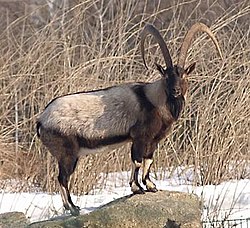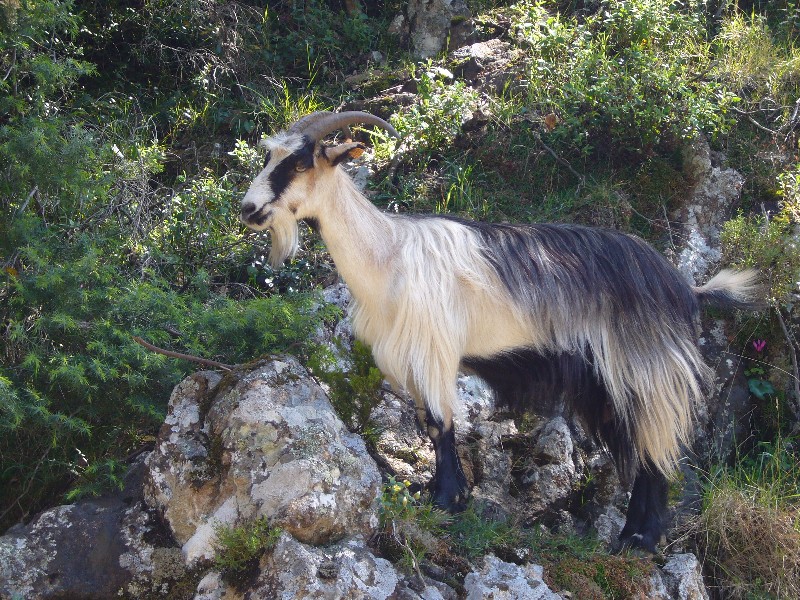Domesticated approximately 10,500 years ago in the Near East--"cradle of the domestication process"--goats were one of the first species of wild animal to be tamed by man. Dispersing Neolithic humans took their livestock with them when they traveled into Europe and beyond, moving goats into locations their ancestor the bezoar (Capra aegagrus) never reached. There are now approximately 867 million goats worldwide, and they can be found living almost everywhere there are humans.
(A bezoar, Capra aegagrus--ancestor of domesticated goats)
Previous genetic studies have been conducted on goats in order to shed light on the domestication process. However, little work has focused on island populations of goats--such as those found on Corsica. Genetically speaking, islands are interesting because they are isolated from the mainland and therefore may experience reduced gene flow; this can preserve rare genes. In the case of domestic animals, unusual genetic patterns may also emerge as a result of certain cultural practices that are maintained on islands long after they go out of favor on the mainland. This is the case on Corsica, where herders let their animals roam free during the period after weaning and before birth of the next young; during this time, the animals forage on the island's rocky volcanic slopes. Another unique husbandry practice is associated with herd formation: Goats are maintained in small family groups in order to promote cohesion; related females are often kept together, with unrelated males introduced in order to "change the blood" and prevent inbreeding.
Cumulatively, these unique characteristics suggest that Corsican goats could be an important source of information on the goat domestication process. Further, a detailed understanding of Corsican goat genetics could help researchers better understand the consequences of recent paratuberculosis infections that have been decimating island flocks.
(The French island of Corsica, in red)
The researchers sampled DNA from 28 present-day individuals and 29 bones from an archaeological dig at Rostino. The modern samples were drawn from herds in 5 different Corsican towns (Moltifao, Tralonca, Corte, Altiani, and Quenza), while the historical samples represent both 12th- and 14th-century herds. Genetic data were used to classify the goats into different haplogroups, or broad categories that indicate descent from shared ancestors. Genetic diversity was then compared between Corsican goats and those found elsewhere in the Mediterranean and around the world.
Medieval Corsican goats all fell within a single haplogroup (A), and DNA from 6 animals yielded genetic sequences that have never before been described. Although individuals from the 12th and 14th centuries had similar genetic diversities, medieval and modern goats did not. This was because modern goats fell into two haplogroups instead of one: haplogroup A and haplogroup C, the first of which is found worldwide and the second of which is found only in Europe (predominantly in the Mediterranean area). When haplogroup C goats were omitted from the analysis, there was no longer a significant difference between goats from the two eras, indicating that Corsican herds have not changed dramatically over the past 800 years.
(Domestic goat, Capra hircus, on Corsica)
The global analysis of haplotypes, or combinations of gene sequences located in close proximity on chromosomes, revealed that both medieval and modern Corsican goats were significantly different from all other groups, suggesting that they are an important endemic variety. When genetic patterns were overlaid onto a geographical map, they formed a "star shape," supporting previous claims that goats radiated outward from a central point of domestication. Corsican goats shared 4 haplotypes with Sardinian goats, and 6 with Portuguese animals--not entirely unsurprising given that all of these animals hail from the Mediterranean region. European and Asian sequences, however, were clearly different: Time, distance, and different husbandry practices have led to divergence between these two groups of livestock.
Overall, the analyses highlight how domestication is not a single event that happened at some distant point in the past, but an ongoing process that continues to impact animals today. Because many industrial breeds experience physiological or morphological problems associated with their reduced genetic diversity, "rustic breeds" are of increasing interest because they can act as a source of genetic variation. Over the past 80 years, the Corsican goat population has dropped from over 200,000 individuals to only 30,000; thus, those who are interested in preserving goat variation may need to start drafting conservation and management plans to protect these unique animals.
---
Hughes, S., Fernandez, H., Cucchi, T., Duffraisse, M., Casablanca, F., Istria, D., Pompanon, F., Vigne, J.-D., Hanni, C., and Taberlet, P. 2012. A dig into the past mitochondrial diversity of Corsican goats reveals the influence of secular herding practices. PLoS ONE 7(1):e30272.
Thanks to the following websites for providing the images used in this post:
http://en.wikipedia.org/wiki/Wild_goat
http://www.alanjoanhere.com/2008_France_Corsica.html
http://en.wikipedia.org/wiki/File:Corse_in_France.svg


No comments:
Post a Comment